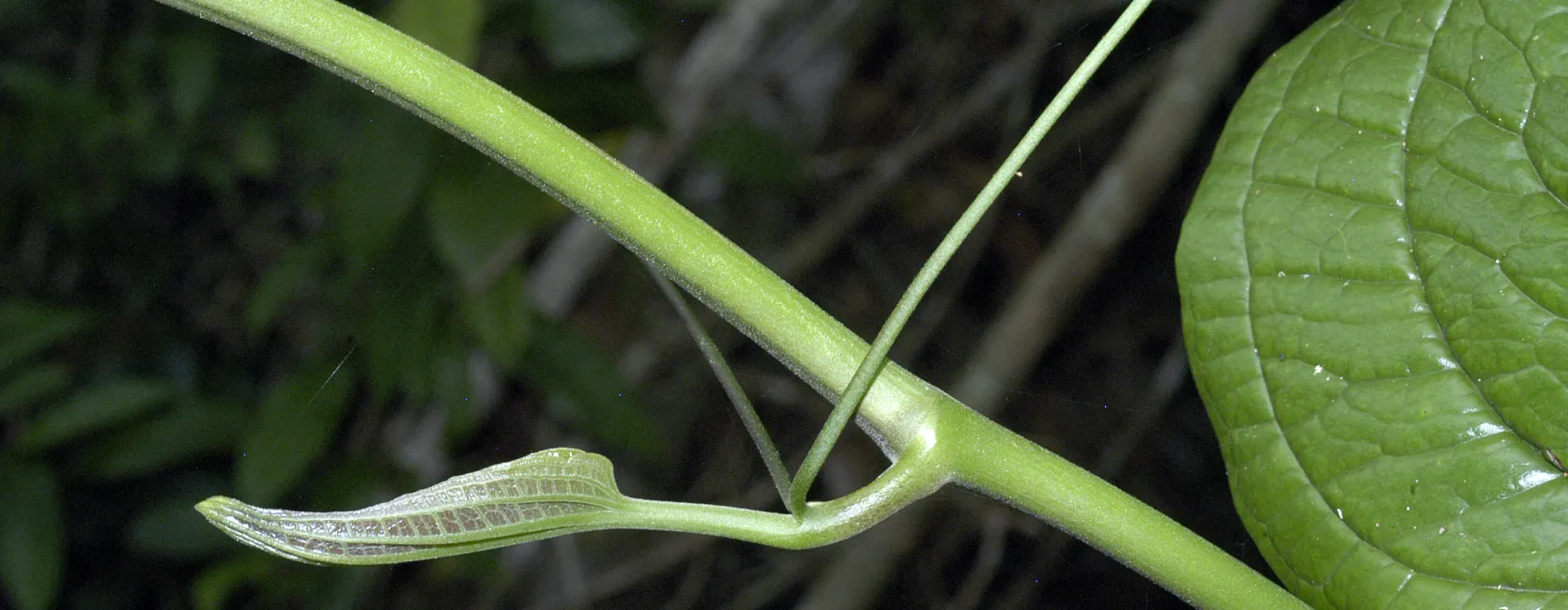Image


Lianas (also known as vines, climbing plants or climbers) are plants with long, flexible, climbing stems that are rooted in the ground, and usually have long dangling branches. In order to climb, they have developed a wide range of climbing strategies and specialized structures affix themselves to the supporting structures. In addition, their woods usually present a wide range of distinctive anatomical structures. Trees and shrubs on the other hand, are distinguished by their self-supporting, rigid, erect, stems. However, the distinction between climbing and self-supporting plants is often blurred by the occurrence of plants with long, semi-rigid stems that arch or lean over other plants. These less efficient climbers are known as clambering, scrambling or leaning plants. The definition of a climbing plant is also obscured by the presence of species that become epiphytes after their climbing stems loose connection with the ground, or by epiphytes that establish contact with the ground by producing long stems or roots that climb down. In this project we have adopted a more comprehensive definition of a climber, so that we include plants with well-defined climbing mechanisms as well as scrambling and leaning plants. Our definition exclude creepers or plants with long, flexible stems that lay on the ground without climbing, our treatment include only climbers that reach more than 2 m in length. Lianas can reach 165m in Rattan palms, and 30-40 cm diameter in Malpighiaceae and in some Fabaceae (Schenella).
Other terms synonymous with climbing plants
lianas – woody climbers with stems reaching more than 10 m in length.
vine, bejuco [Spanish], cipó, trepadeira, corda, icipó [Portuguese] – a general term for climbing plants but often used for herbaceous or slightly woody climbers, the word bejuco is synonymous with liana in many Spanish speaking countries in the Americas.
Twiners, voluble, enredadera [Spanish] - a climber with twining stems such as in family Convolvulaceae and Malpighiaceae.
Ascending, scrambler, leaning, sarmentoso [Spanish] – a vague term that refers to climbers with no specialized climbing mechanism.
Ropes, sogas [Spanish] – vague term that often refers to lianas or woody climbers.
GENERAL CHARACTERISTICS OF CLIMBERS
(Native or naturalized species)
107 Families/726 genera/10265 species
Pteridophytes: 7 families/10 genera/82 species: twiners, scramblers or root-climbers
Gymnosperm: 1 family; 1 genus/7 species: twiners
Magnolids: 5 families/9 genera/276 species: twiners, root-climbers, and scramblers
Monocots: 12 families/46 genera/1154 species: twiners, scramblers, root-climbers, and tendrilled
Eudicots: 82 families/661 genera/8746 species: all climbing mechanisms present
MOST SPECIES DIVERSE FAMILIES IN THE NEOTROPICS
Apocynaceae: 83 genera/1360 species
Asteraceae: 90 genera/892 species
Fabaceae: 60 genera/770 species
Malpighiaceae: 33 genera/600 species
Passifloraceae: 4 genera/600 species
Sapindaceae: 6 genera/488 species
Araceae: 8 genera/425 species
Convolvulaceae: 25 genera/416 species
Bignoniaceae: 24 genera/397 species
Cucurbitaceae: 37 genera/384 species
Dioscoreaceae: 1 genus/278 species
Rubiaceae: 31 genera/259 species
Solanaceae: 19 genera/211 species
Aristolochiaceae: 2 genera/200 species
Menispermaceae: 17 genera/173 species
Euphorbiaceae: 15 genera/168 species
Melastomataceae: 11 genera/140 species
Marcgraviaceae: 7 genera/130 species
Ericaceae: 15 genera/121 species
Smilacaceae; 1 genus/109 species
Celastraceae: 13 genera/105 species
Acanthaceae: 12 genera/103 species
Alstroemeriaceae: 1 gennus/101 species
MOST SPECIES DIVERSE GENERA IN THE NEOTROPICS
(with total number of species)
Passiflora 550
Mikania 328
Dioscorea 278
Ipomoea 267
Serjania 250
Philodendron 211
Paullinia 200
Aristolochia 196
Pentacalia 160
Heteropterys 129
Mandevilla 122
Smilax 115
Solanum 115
Ditassa 105
Bomarea 101
Ruehssia 100
Stigmaphyllon 95
Manettia 95